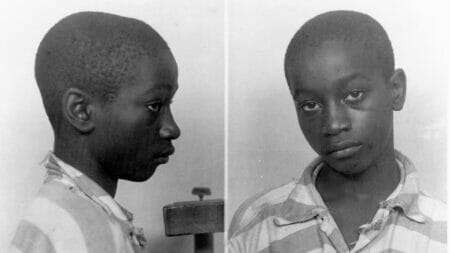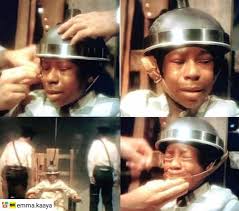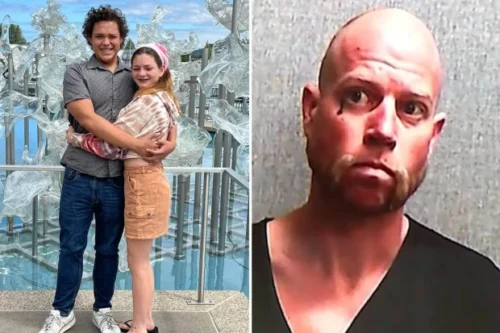George Stinney Innocent But Executed

George Stinney was a fourteen year old teen from South Carolina who was arrested for the murders of two young girls.
According to court documents the bodies of Betty June Binnicker and Mary Emma Thames were found on March 23, 1944. The two girls were reported the night before. Betty June Binnicker died from head injuries as her skull had been crushed. Both of the girls had been beaten with either a metal bar or a railroad spike.
George Stinney and his sister Aime saw the two girls the night before as the victims were looking for flowers and had had asked the pair where they could find a certain flower.
George Stinney and his brother John Stinney would be arrested by police however John would be released. According to George the police starved him and then bribed him to confess to the double murder. According to police George Stinney confessed to the double murders and led police to a piece of metal close to where the two bodies were found. No signed confession was ever found.
George Stinney trial was a farce. The entire jury selection and trial took less than a single day. George attorney for the trial was a tax commissioner who failed to question the alleged confession. There was also no physical evidence tying George to the murders. The prosecutors gave the jury two possible scenarios (A) George was attacked by the two girls and he acted in self defense (B) George was following the girls then attacked them. George attorney put up no defense for the fourteen year old.
George Stinney was convicted by the jury in less than ten minutes. George was sentenced to death.
George Stinney would be executed on June 16, 1944 by the way of the electric chair due to his small size George was sitting on a bible for the execution. George was buried in an unmarked grave.
Seventy years later a local historian began to research on the execution of George Stinney and needless to say a lot did not add up.
- A person who has never been named made a death bed confession to the double murders
- George Stinney siblings have always said that the fourteen year old was with them the entire night
- Evidence shows that there was no blood found at the site meaning that the murders took place elsewhere and the bodies were dumped in the ditch.
- An inmate who spent time with George Stinney during his brief incarceration would say that George told him his confession was forced.
After looking at all of the evidence in the George Stinney case a judge in South Carolina instead of ordering a new trial vacated the conviction.
George Stinney Photos

George Stinney Videos
George Stinney More News
n old storage shed, half swallowed by weeds, shimmers in the hazy winter sunshine opposite the Green Hill Missionary Baptist Church. This is all that remains of the thriving lumber yard and sawmill on which Alcolu, a rural town in South Carolina, was built.
Back in 1944, in the Jim Crow era of the South, Green Hill was known as “the black church”, while Clarendon Baptist Church across the railway tracks was “the white church”. Those who remember the terrible events that unfolded in this dot of a place that spring and summer were children at the time and their memories are shaped by this same racial divide that split the community in two.
From the Green Hill church it is a few minutes’ walk, across a ploughed field littered with corn husks, to the shallow ditch in the woods where the bodies of two girls, Betty June Binnicker, 11, and Mary Emma Thames, seven, were found, side by side, 70 years ago this month. Their murders stunned the townspeople, many of whom had taken part in a search for them the day before. The girls had been gathering flowers when they were followed, attacked and beaten so severely their skulls were fractured. The bodies of the girls, both white, were found on the black side of town.
Suspicion quickly fell on a 14-year-old black boy named George Stinney Jr who, it emerged, had seen the girls the previous day. What happened next has cast a long shadow over the town, the state of South Carolina and the Stinney family. Police said that Stinney confessed to the crimes and, although there was no physical evidence, he was charged with capital murder, tried, convicted and executed by the state – all in the space of 83 days. He was the youngest person to be executed by the United States in the 20th century.
His siblings, three of whom are still alive, believe his confession was coerced and he was a scapegoat for a white community seeking vengeance. Attorneys for George’s sisters Aime Ruffner and Katherine Robinson and brother Charles have now launched a legal bid for the verdict to be overturned. They say they were with him when the murders occurred, evidence that was never presented at his trial. Other new evidence, heard by a court in January, includes an affidavit from the Reverend Francis Batson, who found the girls and pulled them from the water-filled ditch. In his statement he recalls there was not much blood in or around the ditch, suggesting that they may have been killed elsewhere and moved.
Aime Ruffner, now 77, a widow and matriarch of three generations of Stinneys whose pictures line the walls of her three-storey clapboard house in Newark, New Jersey, said she has not returned to Alcolu since her father was sacked from his job at the mill and her family were run out of town the day her brother was taken away. “I never went back there. I curse that place. It was the destruction of my family and the killing of my brother.”
She will never forget the last time she saw George alive. She was eight at the time, hunkering in the chicken coop, scared half to death, when two black cars drove up to their house. Neither her mother, also Aime, a cook, nor her father, George senior, were home when white law enforcement officers came and took away George and her stepbrother, Johnny, in handcuffs. Johnny was later let go. She idolised George and followed him everywhere. He called her his shadow.
Though she left the south long ago, Aime’s rich, deep voice resonates with the vowels of her birthplace. But recalling her last words to George, it alters as if she’s gone back in time, to the high-pitched voice of a girl. “I said: ‘Oh George, are you leaving me? Where you going?’ He told me to find Charles and Katherine and tell them he was taken away.
“I never saw him again until he was in his casket,” said Aime. “That is something I will always see in my memories. His face was burned.”
There is scant documentary evidence from the case, but newspapers reported that, because of his small stature, at 5ft 1in and weighing just 95lb, the guards had difficultly strapping him into a chair built for adults. When the switch was flipped and the first 2,400 volts surged through his body, the too-large death mask slipped from his face revealing the tears falling from his scared, open eyes. A second and third charge followed. He was pronounced dead on 16 June 1944.
Aime gets up from her doily-covered table where, before our interview, she had been conducting her day’s business, writing cheques and paying bills, and goes to the living room to find photographs. A dog yaps in another room. The television is on, a family sitcom running. She emerges with a thick poster-size print, in which a black-and-white image of George’s face, taken from his prison mug shot, is surrounded by purple fluffy clouds and the words: “George’s place is here.” Another photograph shows him in a cap and an overly large jacket, the same serious look on his face.
From the moment he was picked up until after his trial on 24 April, the child was not allowed to see his parents. He was alone throughout and faced a jury of 12 white men, who took less than 10 minutes to deliberate as a mob of up to 1,500 people surrounded the courtroom, according to reports.
Aime’s parents were allowed to visit their son only once, at Columbia penitentiary, after the trial. They returned, convinced of his innocence but, as poor blacks in the south, with little recourse. “My mother cried and prayed,” said Aime. “We wanted the truth to come out. But sometimes when you don’t have the means and the money you accept things for what they are. The NAACP [National Association for the Advancement of Coloured People] tried to stop it, but it was no use. In those days, when you are white you were right, when you were black you were wrong.”
Aime and her surviving siblings, Charles who was 12 and Katherine who was 10, grew up with two beliefs: that their brother was innocent and that they couldn’t change the past. In legal documents submitted to the new hearing, Bishop Charles Stinney told of how the entire family were plunged into fear after George was taken and his father fired. Amid talk of a mob, they had to leave town for their grandmother’s home in nearby Pinewood and later moved to Sumter.
His parents were helpless, Charles said. “They had no money, the law was against them and they were black in the American south in 1944.” Lynchings were rare by the 1940s, but memories of southern vigilantism in the 1920s and earlier were bitter. One by one, the Stinney siblings moved north and settled in New York and Newark. They rarely spoke of what happened and have only recently given detailed testimony.
Charles, 83, a widower with five grown-up children, left Sumter for the Air Force before becoming bishop of the Church of the Lord Jesus Christ, in Brownsville, Brooklyn, one of New York’s most deprived neighbourhoods. He has spent his life trying to put it all behind him, he said, to “stop opening old wounds”.
As a minister, he believes God knows the truth about his brother, a sociable boy who would get friends together to sing along to the radio in the yard. “Nothing will bring him back and nothing will bring those girls back,” he said. Nevertheless “It is important to have his name cleared.” Aime sought the help of an attorney and wrote a letter to Oprah Winfrey, she said. Both approaches went nowhere.
The catalyst for the legal action came via George Frierson, a local historian and a member of Clarendon’s School District Three’s board of trustees, who was born in Alcolu and went to elementary school when the lumber yard was still running. Frierson began investigating the case in 2004 after a small piece in a local newspaper reminded him of it. Frierson said the more he researched, the more he became convinced by George’s innocence. He says there was little blood at the ditch, evidence that the girls were killed elsewhere. “A 95lb boy can’t carry two dead bodies a quarter mile or more. Those girls were beaten to a pulp. There would have been a lot of blood.”
His work caught the interest of Steve McKenzie and Matt Burgess, white attorneys from Coffey, Chandler & McKenzie, who took on the case for the Stinney family.
McKenzie filed papers at the county solicitor in October 2013 to ask to have George’s verdict overturned. He, Burgess and Miller Shealy, a professor of criminal procedure at the Charleston School of Law, presented new evidence which included sworn statements by Charles and Aime that they were with George the day the girls went missing. Wilford “Johnny” Hunter, who was in prison with George, also testified that the teenager told him he had been made to confess.
Aime says her story hasn’t altered in 70 years, although at the hearing she was accused by prosecutors of not remembering details of a statement she had given in 2009. She said the events of 24 March 1944, when she and George came across the girls, were so clear in her mind because “no white people came around” to the black side of town. She and George were sitting on the railroad tracks when the girls approached and asked if they knew where they could find maypops, a kind of fruit. They answered no, she said, and they left. “We didn’t see those girls no more. But somebody followed those girls and killed them.”
She insists that George’s confession was forced out of him. “They made him confess. They never found the statement. Why would my brother confess to something he didn’t do?” The confession, if it was ever written down or signed, has not survived, along with the transcript of the trial.
Attempts to overturn the conviction have met with resistance among Alcolu’s white community. Sadie Duke told the local paper in January 2014 that the day before the murders, George had told her and a friend: “If you don’t get away from here and if you ever come back, I will kill you.” Another local, who was 15 at the time, said George was known as a bully.
Asked whether she recognised this version of her brother, Aime says: “The only white kids that came in our area was those kids. We had our own black school and church. We didn’t fool around with white people.” Members of Alcolu’s black community say that it was unlikely that, in the segregated town, any black child would threaten white children without there being repercussions.
However, back in 1995, WL Hamilton, George’s seventh grade teacher, who is black, told the Item newspaper that he had a temper and had got into a fight with a girl at school, scratching her with a knife. Aime said she phoned Hamilton after she read the story. “That bastard. That was a damn lie. When I heard about that lie Mr Hamilton told I called him up. I said my name is Aime Stinney and you said my brother was a bad boy. You’ve got one foot on a banana peel and the other going straight to hell.”
Betty June Binnicker’s family never moved too far from Alcolu. A few weeks ago Frankie Bailey Dyches, Betty June’s niece, helped organise a gathering of family and acquaintances to counter what she said was a false impression of George Stinney. In a restaurant outside Manning, less than five miles away, Frankie and her cousin Carolyn Geddings talk about the case over the detritus of a southern lunch of fried chicken, prime ribs, rice and gravy. Dyches and Geddings, both 62, have grown up with the grief of their mothers, Betty June’s elder sisters, and their grandparents Daisy and John Binnicker. To them, George’s confession, and a handwritten note from a Clarendon County deputy stating he confessed and had led them to the murder weapon – a 15in railroad spike – was proof enough of his guilt.Advertisement
“It seems like a poor little black boy was railroaded by the white people, but that’s not how it was,” said Dyches. “I’m 100% convinced he did it.” One of the investigating officers, Mr Pratt, had told her before he died never to doubt George’s guilt.
“The stories we hear are that he was a shy bashful boy, but he was a bully and he was mean,” she said, citing allegations by Duke and others. She questions the memories of the Stinney family, the motivation of the attorneys and the timing of the appeal. “Why now? What about in the 1960s, when the civil rights movement was starting? What about in the 1970s or 80s? One was a school teacher. It’s not as though they weren’t educated.”
She believes the attorneys are motivated by money, citing a website they set up, and that they will sue the state for wrongful death if George is exonerated. The lawyers say the site is for litigation fees only, with any remaining going to a scholarship foundation, have no interest in suing for wrongful death and do not know if that is even possible.
Betty’s parents had already lost a baby son, Harold, when he was six months old and, after Betty June, lost a third child, a son who died on duty in the Korean war. According to the family they never recovered. Carolyn added: “For Betty June to be killed in such a horrible way – it was a terrible time for all of them.”
The cousins insist that there was no racial element to George’s trial and conviction. But they disagree over whether the state was right to execute him. “I’m a believer in the death penalty if you are 100% sure and I believe he did it,” said Frankie. Carolyn is more sympathetic to the view that grave mistakes were made in the case. She said George should have had a lawyer or parent with him during his interrogation, and should never have been put to death.
“I feel bad for his family, all of them,” said Carolyn. “They had to live with it, same as we have. My mother, Vermelle, didn’t think he should have been electrocuted. She thought because of his age that he shouldn’t. At this point, after years of this, if the judge rules it wasn’t fair then I’m happy with that. I hope the family can get some peace from it.”
In the South CAROLINA state archives in Columbia, a thick file offers an insight into the outrage the upcoming execution of a minor caused at the time. Hundreds of letters and telegrams urged the governor, Olin Johnston, to commute the sentence to life imprisonment. Some cited a recent case, where a 16-year-old white boy from Parish Island was given a 20-year sentence for murder and rape. Others begged for a new investigation and trial. Many spoke of the war, in which black and white men were fighting and dying in equal numbers for their country.Advertisement
Johnston, who was running for the US Senate at the time, was unmoved. In one letter, dated 14 June, two days before the execution, Johnston wrote to a VM Ford of Myrtle Beach who had asked for clemency, that he had spoken with the arresting officer. He said: “It may be interesting for you to know that George Stinney killed the smaller girl to rape the larger one. Then he killed the larger girl and raped her dead body. Twenty minutes later he returned and attempted to rape her again, but her body was too cold. All of this he admitted himself.” This was rumour – and was contradicted by the physical examination at postmortem.
Johnston was not the only one running for office. Charles Plowden, George’s appointed defence attorney, was also running for the statehouse. Two conflicting confessions by George Stinney were entered as evidence at the trial, according to reports. In the first, he said he was approached by the girls who attacked him after he tried to help one who had fallen into a ditch and he struck them in self-defence. In the second version, he had followed the girls into the woods and first attacked and fatally wounded Mary Emma, to “get her out of the way”, and then chased Betty June and struck her.
The trial court allowed the permissibility of the “possibility” of rape, despite the lack of evidence. The medical report states that, while there was slight swelling and a slight bruise on the external genitalia of Betty June, the hymens of both girls were intact.
The attorney Matt Burgess believes George’s confession was changed to fit the prosecution. “The confession changed to fit the elements. The murder weapon changed. It was a piece of iron, then a spike and then a railroad spike. That changed in a manner beneficial to law enforcement. In 1944, a 14-year-old black kid interrogated by white officers… They probably put different scenarios to him. I’m guessing he just said, ‘Yes sir’ a lot.”
At Sumter County courthouse in January, Circuit Judge Carmen Mullen stressed that her job was not to establish the guilt or innocence of George Stinney, who “may well have committed this crime”, but to determine whether or not he received a fair trial.
She said: “No one can justify a 14-year-old child charged, tried, convicted and executed in some 80 days.” The injustices, she said, included a witness who discovered the victims’ bodies being allowed to sit on the coroner’s inquest; a trial that lasted less than a day; a state-appointed defence lawyer, Plowden, who did not call any witnesses, ask any questions on cross-examination, offered little or no defence and filed no appeal. Mullen concluded: “In essence, not much was done for this child when his life lay in the balance.” Her ruling is expected any day.
The population of Alcolu has shrunk from 1,700 in 1944 to 400 today. Aime said she has no hate in her heart “for no man, even the ones that killed my brother. I feel sorry for the families that lost those little ones. They lost their children and I lost a brother. That hurts. But for people to sit down and form a judgment in the way they did? To electrocute him? They burned him. It was a horrible death for a child.”
https://www.theguardian.com/theobserver/2014/mar/22/george-stinney-execution-verdict-innocent






